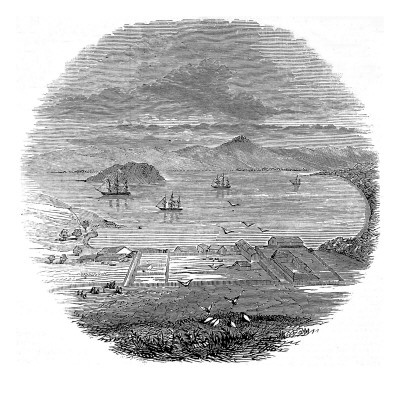Passengers at the Port of San Francisco: 1800s

William Alexander Leidesdorff
1810 - 1848
Leidesdorff was a pre-Gold Rush pioneer born out of wedlock in the Virgin Islands to a Danish sugar planter and Anna Marie Spark, a native woman having Negro blood. After his father drifted off, he was taken in by an English plantation owner; he left his home to live in New Orleans to work with a cotton merchant, brother the English gentleman.
Leidesdorff flourished in the maritime trade out of New Orleans sailing to New York. He desired to marry a New Orleans belle, but when her father learned of his heritage, he was not allow his daughter to marry him.
|
He sold his personal effects in New Orleans, bought the 106-ton schooner, Julia Ann, and prepared for a trading voyage to San Francisco, landing at Yerba Buena Cove in 1841.
His business ventures include launching the first steamboat to sail on San Francisco Bay. Apparently she had no name, but has since been called the Sitka. Her dimensions were: length, 37 feet; breadth of bow, 9 feet; depth of hold, 3 1/2 feet; drawing, 18 inches of water, and having side wheels moved by a miniature engine. She was built by an American at Sitka, as a pleasure boat for the officers of the Russian Fur Company and was purchased by Leidesdorff, being brought down to San Francisco in October, 1847.
By November 28th, the Sitka began carrying goods and transporting passengers as far as Monterey. The Sitka was wrecked at her anchorage in Yerba Buena in a gale but was saved, hauled inland by oxen, her named changed to Rainbow. She ran on the Sacramento River even after the discovery of gold.
Leidesdorff was naturalized in 1844, and obtained a grant of thirty-five acres of land, to which he gave the name the ?Rio De Los Americanos? ranch, located on the left bank of the American River. He he continued to establish himself as a business man of amazing acumen when he bought a lot on the corner of Clay and Kearny and built the town?s first hotel, which he named the ?City Hotel.?
Later, extending his import-export trade (particularly in tallow and hides), he built a warehouse on the corner of California and Leidesdorff streets, the latter being the short street on the waterfront of the Embarcadero of the day, which was named for him.
In 1845, Leidesdorff was appointed Vice Consul to Mexico by Consul Thomas Oliver Larkin, serving under the jurisdiction of Commodore Stockton, then military governor of California. In this capacity Leidesdorff gave aid to Fremont and the Americans raising the Bear flag in the historic rebellion at Sonoma in 1846.
Leidesdorff remained a bachelor, yet he lived in one of the largest homes in the area (on the corner of California and Montgomery Streets) from which he played host to government officials, American or Mexican. His cuisine offered the finest foods and wines and he could boast the only flower garden in all Yerba Buena. He held civic positions of honor and trust. He was a member of the town?s first council; he was town treasurer, and one of the three members of the first school board which supervised the building of the first public school erected for children in the community. In a lighter vein, he found occasion in the field of sports, to indulge the lively spirit of speculation and daring which he brought with him into California.
Among his last ventures, in 1847, was the staging of the state?s first horse race, on a ?meadow? near Mission Dolores, especially improvised for this unprecedented event.
Leidesdorff died of brain fever in 1848 at the early age of thirty-eight. In his death he was accorded the highest recognition a bereaved community could tender a beloved and honored citizen. Flags hung at half-mast from all military barracks and vessels in the port. Minute guns were fired as the funeral procession made its way through the winding streets to Mission Dolores, where with imposing ceremonies his body was laid to rest.
William Alexander Leidesdorff
First Black Millionaire, American Consul and California Pioneer
Gary Palgon
Joseph Libby Folsom, captain in the U. S. Army and at one time collector of the port, journeyed all the way to the Virgin Islands in search of Anna Marie Spark, Liedesdorff's mother, who still lived in the islands with her other children. Folsom paid her the sum of $75,000 to gain absolute title to the whole of the Leidesdorff property.












 Copyright ~ 1998-2018.
Copyright ~ 1998-2018. 